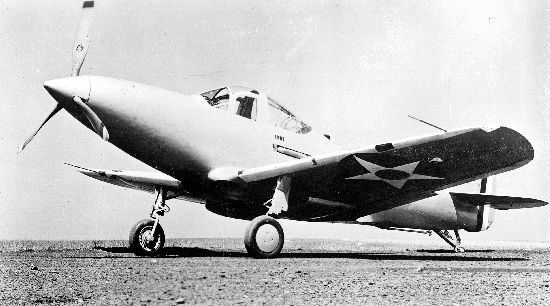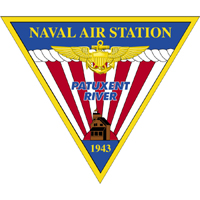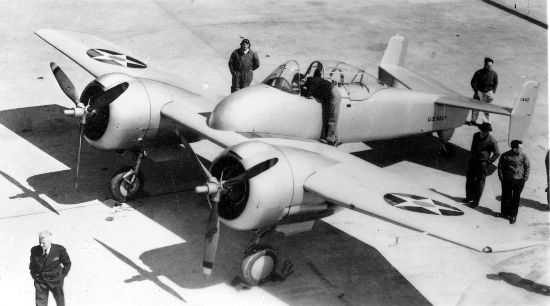|
Bell FL Airabonita
The Bell XFL Airabonita was an American experimental carrier-based interceptor aircraft developed for the United States Navy by Bell Aircraft Corporation of Buffalo, New York. It was similar to and a parallel development of the U.S. Army Air Corps’ land-based P-39 Airacobra, differing mainly in the use of a tailwheel undercarriage in place of the P-39's tricycle gear. Only one prototype was built. Design and development The XFL-1 (Bell Model 5) was powered by a single 1,150 hp (858 kW) Allison XV-1710-6 liquid-cooled V12 engine installed amidships behind the pilot and driving a three-bladed Curtiss Electric propeller in the nose through a 10.38 ft (3.16 m) extension shaft. The aircraft had provisions for a single 37 mm (1.46 in) Oldsmobile T9 cannon which could be replaced by a .50 in (12.7 mm) Browning M2/AN machine gun firing through the propeller shaft and two .30 in (7.62 mm) machine guns in the fuselage nose. It first fle ... [...More Info...] [...Related Items...] OR: [Wikipedia] [Google] [Baidu] |
Carrier-based Aircraft
Carrier-based aircraft, sometimes known as carrier-capable aircraft or carrier-borne aircraft, are naval aircraft designed for operations from aircraft carriers. They must be able to launch in a short distance and be sturdy enough to withstand the abrupt forces of launching from and recovering on a pitching deck. In addition, their wings are generally able to fold up, easing operations in tight quarters. Such aircraft are designed for many purposes including air-to-air combat, surface attack, anti-submarine warfare (ASW), search and rescue (SAR), transport (COD), weather observation, reconnaissance and airborne early warning and control (AEW&C) duties.Fred T Jane (2005). ''Jane's All the World's Aircraft''. Jane's Information Group. The term is generally applied only to fixed-wing aircraft, as naval helicopters are able to operate from a wider variety of ships, including helicopter carriers, destroyers, frigates and container ships. History The 1903 advent of fixed-win ... [...More Info...] [...Related Items...] OR: [Wikipedia] [Google] [Baidu] |
Landing Gear
Landing gear is the undercarriage of an aircraft or spacecraft that is used for takeoff or landing. For aircraft it is generally needed for both. It was also formerly called ''alighting gear'' by some manufacturers, such as the Glenn L. Martin Company. For aircraft, Stinton makes the terminology distinction ''undercarriage (British) = landing gear (US)''. For aircraft, the landing gear supports the craft when it is not flying, allowing it to take off, land, and taxi without damage. Wheeled landing gear is the most common, with skis or floats needed to operate from snow/ice/water and skids for vertical operation on land. Faster aircraft have retractable undercarriages, which fold away during flight to reduce drag. Some unusual landing gear have been evaluated experimentally. These include: no landing gear (to save weight), made possible by operating from a catapult cradle and flexible landing deck: air cushion (to enable operation over a wide range of ground obstacles and wat ... [...More Info...] [...Related Items...] OR: [Wikipedia] [Google] [Baidu] |
Vought F4U Corsair
The Vought F4U Corsair is an American fighter aircraft which saw service primarily in World War II and the Korean War. Designed and initially manufactured by Chance Vought, the Corsair was soon in great demand; additional production contracts were given to Goodyear, whose Corsairs were designated FG, and Brewster, designated F3A. The Corsair was designed and operated as a carrier-based aircraft, and entered service in large numbers with the U.S. Navy in late 1944 and early 1945. It quickly became one of the most capable carrier-based fighter-bombers of World War II. Some Japanese pilots regarded it as the most formidable American fighter of World War II and its naval aviators achieved an 11:1 kill ratio. Early problems with carrier landings and logistics led to it being eclipsed as the dominant carrier-based fighter by the Grumman F6F Hellcat, powered by the same Double Wasp engine first flown on the Corsair's initial prototype in 1940. Instead, the Corsair's early deployme ... [...More Info...] [...Related Items...] OR: [Wikipedia] [Google] [Baidu] |
Turbosupercharger
In an internal combustion engine, a turbocharger (often called a turbo) is a forced induction device that is powered by the flow of exhaust gases. It uses this energy to compress the intake gas, forcing more air into the engine in order to produce more power for a given displacement. The current categorisation is that a turbocharger is powered by the kinetic energy of the exhaust gasses, whereas a is mechanically powered (usually by a belt from the engine's crankshaft). However, up until the mid-20th century, a turbocharger was called a "turbosupercharger" and was considered a type of supercharger. History Prior to the invention of the turbocharger, |
Lockheed P-38 Lightning
The Lockheed P-38 Lightning is an American single-seat, twin piston-engined fighter aircraft that was used during World War II. Developed for the United States Army Air Corps by the Lockheed Corporation, the P-38 incorporated a distinctive twin-boom design with a central nacelle containing the cockpit and armament. Along with its use as a general fighter, the P-38 was used in various aerial combat roles, including as a highly effective fighter-bomber, a night fighter, and a long-range escort fighter when equipped with drop tanks. The P-38 was also used as a bomber-pathfinder, guiding streams of medium and heavy bombers, or even other P-38s equipped with bombs, to their targets."P-38 Lightning" National Museum of the United States Air Force. Retrieved 21 January ... [...More Info...] [...Related Items...] OR: [Wikipedia] [Google] [Baidu] |
Curtiss P-40 Warhawk
The Curtiss P-40 Warhawk is an American single-engined, single-seat, all-metal fighter and ground-attack aircraft that first flew in 1938. The P-40 design was a modification of the previous Curtiss P-36 Hawk which reduced development time and enabled a rapid entry into production and operational service. The Warhawk was used by most Allied powers during World War II, and remained in frontline service until the end of the war. It was the third most-produced American fighter of World War II, after the P-51 and P-47; by November 1944, when production of the P-40 ceased, 13,738 had been built,Murphy and McNiece 2009, p. 83. all at Curtiss-Wright Corporation's main production facilities in Buffalo, New York. P-40 Warhawk was the name the United States Army Air Corps gave the plane, and after June 1941, the USAAF adopted the name for all models, making it the official name in the U.S. for all P-40s. The British Commonwealth and Soviet air forces used the name Tomahawk for models e ... [...More Info...] [...Related Items...] OR: [Wikipedia] [Google] [Baidu] |
Grumman F4F Wildcat
The Grumman F4F Wildcat is an American carrier-based fighter aircraft that entered service in 1940 with the United States Navy, and the British Royal Navy where it was initially known as the Martlet. First used by the British in the North Atlantic, the Wildcat was the only effective fighter available to the United States Navy and Marine Corps in the Pacific Theater during the early part of the Second World War. The disappointing Brewster Buffalo was withdrawn in favor of the Wildcat and replaced as aircraft became available. With a top speed of , the Wildcat was outperformed by the faster (), more maneuverable, and longer-ranged Mitsubishi A6M Zero. US Navy pilots, including John "Jimmy" Thach, a pioneer of fighter tactics to deal with the A6M Zero, were greatly dissatisfied with the Wildcat's inferior performance against the Zero in the battles of the Coral Sea and Midway. The Wildcat has a claimed air combat kill-to-loss ratio of 5.9:1 in 1942 and 6.9:1 for the entire war.Po ... [...More Info...] [...Related Items...] OR: [Wikipedia] [Google] [Baidu] |
Naval Air Station Patuxent River
Naval Air Station Patuxent River , also known as NAS Pax River, is a United States naval air station located in St. Mary’s County, Maryland, on the Chesapeake Bay near the mouth of the Patuxent River. It is home to Headquarters, Naval Air Systems Command (NAVAIR), the U.S. Naval Test Pilot School, the Atlantic Test Range, Patuxent River Naval Air Museum, and serves as a center for test and evaluation and systems acquisition relating to naval aviation. The station also operates a small outlying field, NOLF Webster. Commissioned on April 1, 1943, on land largely acquired through eminent domain, the air station grew rapidly in response to World War II and continued to evolve through the Cold War to the present. Geography The Naval Air Station Patuxent River site is located in Lexington Park, Maryland, at the confluence of the Patuxent River and the Chesapeake Bay on a peninsula known as Cedar Point. History Genesis: 1937 Prior to 1937 was once prime farmland, consisting o ... [...More Info...] [...Related Items...] OR: [Wikipedia] [Google] [Baidu] |
Naval Support Facility Anacostia
Naval Support Facility (NSF) Anacostia was a United States Naval Base in Washington, D.C., close to where the Anacostia River joins the Potomac River. On 1 October 2010 the base was conjoined with the adjacent Bolling Air Force Base to form the Joint Base Anacostia–Bolling in accordance with congressional legislation implementing the recommendations of the 2005 Base Realignment and Closure Commission. NSF Anacostia fell under the command of Naval Support Activity Washington. History Prior to European colonization, the area where the Naval Support Facility Anacostia was located was inhabited by the Nacotchtank, an Algonquian people. The largest village of the Nacotchtank was located just north of Bolling Air Force Base, south of Anacostia Park. Two ossuaries (burial grounds) have been discovered at Bolling Air Force Base. Other Nacotchtank archaeological sites have been found at Giesboro Point on the Potomac River, close to where the Naval Support Facility was once located. ... [...More Info...] [...Related Items...] OR: [Wikipedia] [Google] [Baidu] |
Vought XF4U-1 Corsair
The Vought F4U Corsair is an American fighter aircraft which saw service primarily in World War II and the Korean War. Designed and initially manufactured by Chance Vought, the Corsair was soon in great demand; additional production contracts were given to Goodyear, whose Corsairs were designated FG, and Brewster, designated F3A. The Corsair was designed and operated as a carrier-based aircraft, and entered service in large numbers with the U.S. Navy in late 1944 and early 1945. It quickly became one of the most capable carrier-based fighter-bombers of World War II. Some Japanese pilots regarded it as the most formidable American fighter of World War II and its naval aviators achieved an 11:1 kill ratio. Early problems with carrier landings and logistics led to it being eclipsed as the dominant carrier-based fighter by the Grumman F6F Hellcat, powered by the same Double Wasp engine first flown on the Corsair's initial prototype in 1940. Instead, the Corsair's early deployme ... [...More Info...] [...Related Items...] OR: [Wikipedia] [Google] [Baidu] |
Grumman XF5F-1 Skyrocket
The Grumman XF5F Skyrocket was a prototype twin-engined shipboard fighter interceptor. The United States Navy ordered one prototype, model number G-34, from Grumman Aircraft Engineering Corporation on 30 June 1938; its designation was XF5F-1. The aircraft had a unique appearance: The forward "nose" of the fuselage did not extend forward of the wing. Provisions were included for two 20 mm (0.906 in) Madsen cannon as armament. Design and development In 1938 Grumman presented a proposal to the U. S. Navy for a twin engine carrier based aircraft, unlike any other fighter aircraft that had ever been considered. The design was for a lightweight fighter (under 10,000 lbs maximum takeoff weight) powered by two 1,200 hp Wright R-1820 engines, with propellers geared to rotate in opposite directions to cancel out the effects of each engine's torque, promising high-speed, and an outstanding rate of climb. The XF5F Skyrocket was a low-wing monoplane with a short fuselage ... [...More Info...] [...Related Items...] OR: [Wikipedia] [Google] [Baidu] |









_004.jpg)

